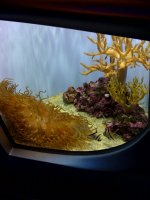A
Anonymous
Guest
I've gone to this site a few times over the last couple of years, and just re-stumbled upon it last night. It has tons of great information, a lot of it much more in-depth than other similar resources, such as Fishbase.org. It'd be great for anyone looking to research natural habitats, maybe to set up a biotope or something. Here's an example section from the Pterapogon kauderni page; talk about detail!
Ecology: Habitat :The Banggai Cardinalfish occurs primarily on shallow sheltered bays and harbors, mainly on silty reef flats with sandy bottoms and sea grass beds . Depth distribution is generally ranges between 0.5 and 6 m , but is most commonly found between 1.5 and 2.5 m. Some populations inhabit very clear waters in coral reef areas , while others inhabit still, murky bays, and some groups are found in sandy patches associates with anemones, and less commonly, in open habitats (low branching corals and rubble ). This species inhabits a variety of shallow habitats, including coral reefs (51% of identified groups), seagrass beds (35%), and open areas of sand and rubble (14%). It is most common in calm habitats on the protected side of larger islands; isolated populations also occur in areas affected by strong surge and moderate currents Water temperatures in these habitats range from 28°C to 33°C (Vagelli and Erdmann 2002, Vagelli 2005). There is an ontogenetic shift in habitat and microhabitat use between juveniles and adults that occurs within the same area and depth; all size classes, including mating pairs and brooding males, overlap in their distribution; the shift in use is not the consequence of differential feeding habitats nor intraspecific competition (Vagelli 2004a). The processes governing this ontogenetic shift are not clear. No pre-settlement factor is involved, however, because this species lacks a pelagic larval phase and embryos released by brooding males settle into parental habitat directly (Vagelli 1999, 2002, 2004a; Vagelli and Volpedo 2004).Juveniles associate with sea grasses, sea urchins, sea stars, sea anemones, soft corals and corals. Adults shelter between the spines of sea urchins but also among anemones, corals, stony hydrozoans , rocks and artificial structures such as jetties (Allen 2000, Vagelli and Erdmann 2002, Vagelli 2004a). Sea anemones utilized include Actinodendron sp. , Entacmaea quadricolor, Heteractis crispa, Macrodactyla doreensis, Stichodactyla haddoni, and S. merteensis. Corals include Acropora sp., Anacropora sp., Echinopora horrida, Goniopora sp., Heliofungia actiniformis, Montipora digitata and Seriotopora hystrix. Soft corals utilized include Nephthea sp. and stony hydrozoans include Millepora sp. Sea urchin species utilized include Diadema setosum and Tripneustes sp., while the sea star is Proteaster nodosus. Banggai Cardinalfishes also associate with the submerged roots of mangroves (Rhizophora sp.). Census work showed that 43.7% of the groups were associated with hard corals, 31.9% with urchins Diadema setosum, and 24.4% with anemones (Allen 2000; Vagelli and Erdmann 2002; Vagelli 2004a, 2005).Ecology:When sheltering in anemones and Heliofungia corals, P. kauderni often associates with various species of anemone fishes (Amphiprion) and anemone shrimps (Periclimenes), and with several species of Apogonidae (Apogon, Archamia, Cheilodipterus and Sphaeramia when living among spines of sea urchins. In seagrass beds (predominantly composed of Enhalus acoroides), P. kauderni is associated with anemones, isolated live corals, sea urchins or sea stars forming small fish assemblages , commonly with Abudefduf sexfasciatus and several species of Pomacentrus, Chromis and Halichoeres.Diet :As opposed to other described apogonids, P. kauderni has diurnal trophic habits, and its feeding activity decreases with the day and ceases around sunset time. P. kauderni is a carnivore-planktivore that feeds principally upon copepods , but it is also a generalist opportunistic species that feed upon a variety of taxa, principally planktonic demersal and benthic organisms . Stomach content analysis found prey representing 29 taxa with a taxonomic level of suborder or higher belonging to 6 phyla: Rhyzopoda, Annelida, Mollusca, Arthropoda, Chaetognatha , and Chordata. There were no significant differences in diet composition between size classes. Quantitative analysis showed that copepods make up about 79% of P. kauderni diet, and that other important components are decapods and isopods . There was an important variation in diet composition among the sites. Representative food items include ascidian larvae, chaetognaths , post-settled gastropod and bivalve juveniles, polychaetes , acarids, copepods, amphipods , stomatopods, cumaceans, isopods, euphausiids , ostracods , cirriped larvae, mysids , decapod larvae, tanaidaceans, and the larvae of teleost and chironomid insects (Vagelli and Erdmann 2002, Vagelli 2005).Group Size:Within its natural geographic range P. kauderni formed groups with a mean of 9.5 individuals, although the majority of them were composed of fewer individuals. Group size varied with age class , habitat and microhabitat. The mean size of the 448 censed groups (3,672 individuals) was 8.2 individuals, and the group means per site ranged from 3.9 to 19.8 individuals. Most groups (73% of all groups) were composed by few individuals (1 to 6). The largest single group found was about 500 individuals (Vagelli and Erdmann 2002, Vagelli 2005).






